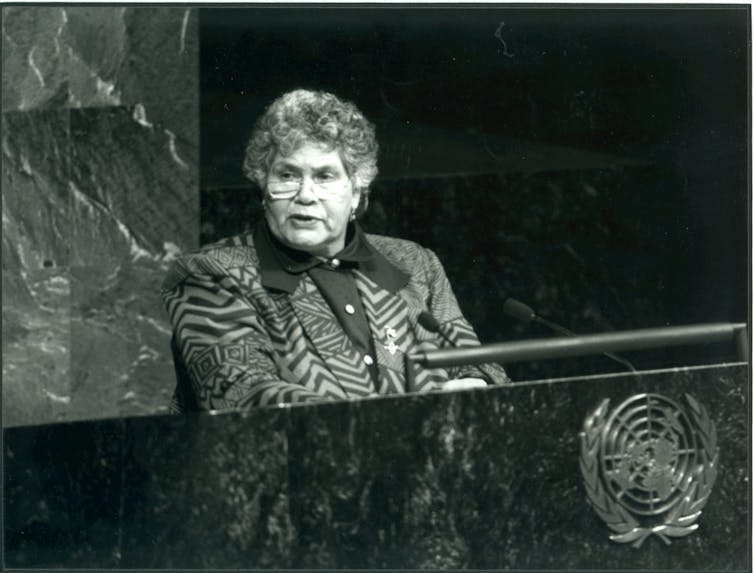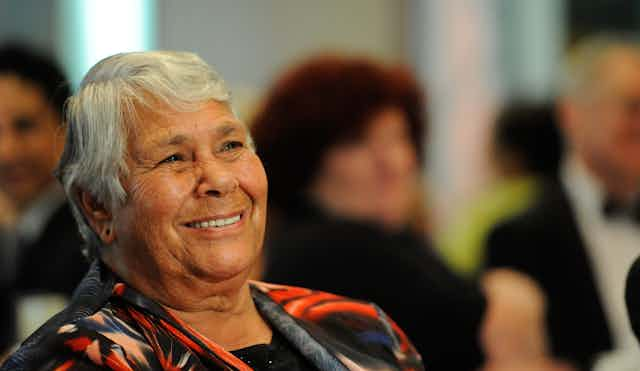Aboriginal and Torres Strait Islander readers are advised this article contains the name and images of a deceased person.
In the many tributes that have flowed since the announcement of Lowitja O’Donoghue’s death on February 4 at age 91, many commentators have noted her leadership and commitment to public life over many years.
Of her many public roles, chairing the Aboriginal and Torres Strait Islander Commission (1990-2005) across the first six years of its life stands out. No other Indigenous leader has occupied a similar position before or since.
What can we learn from her leadership?
An activist and trailblazer
Removed, marginalised and discriminated against from birth, in a country that refused to recognise her identity or aspirations, O'Donoghue’s political maturation came early when she moved to Adelaide to become a trainee nurse in the 1950s.
There she joined the Aborigines Advancement League and helped spearhead campaigns for civil rights.
Read more: Indigenous trailblazer Lowitja O'Donoghue dies aged 91
In 1967 she joined the Commonwealth Department of Aboriginal Affairs, rising to become regional director from 1975-79. In 1977, O'Donoghue was appointed the inaugural chair of the National Aboriginal Conference (NAC) and subsequently appointed as chair of the Aboriginal Development Commission.
She was also chair of Aboriginal Hostels Ltd from 1982-90 and a founding member of the Council of Aboriginal Women of South Australia.
In 1984, she was commissioned by Aboriginal Affairs Minister Clyde Holding to consult with Indigenous communities about a new consultative organisation to replace the NAC. A key recommendation of her report was the establishment of regional assemblies across Australia, a model that became central to ATSIC.
Inaugural chair of ATSIC
O'Donoghue was regarded as the logical choice for inaugural chair of ATSIC. A statutory body, combining representative, advisory and administrative functions, ATSIC was unlike all previous representative bodies for Indigenous Australians.
She steered a board of 17 regional commissioners, along with an extra two commissioners appointed by the minister. There were also between 600 and 800 regional councillors (including chairpersons) in 35 regions across Australia, prosecuting a national position while catering to regional concerns.
She liaised with a chief executive and the minister, and an administrative wing of about 1,000 public servants. She and the board administered 50% of the federal government’s budget in Aboriginal affairs, dispensing something in the order of 6,000 grants to about 1,500 incorporated Indigenous organisations by the mid 1990s.
Read more: Many claim Australia’s longest-running Indigenous body failed. Here’s why that’s wrong
O’Donoghue took to the task with gusto and hope. Her first order of business was steering a national Aboriginal response to the 1991 report of the Royal Commission into Aboriginal Deaths in Custody, which she described as the “most important social document of the 20th century”. She attended as many regional council meetings as she could and, in an historic cabinet meeting in 1991, was among a small group that presented a report to Paul Keating on Aboriginal priorities.
Negotiating Mabo
Not long after this, O'Donoghue was required to steer ATSIC’s response to the Mabo decision. This was no small task, as it unleashed a torrent of discontent across Australia and resistance in many quarters.
O’Donoghue, ATSIC and other Aboriginal representatives developed a list of bedrock demands. Compromises were made, but under O'Donoghue’s determined steerage, ATSIC hung on to several demands, notably the retention of the threatened Racial Discrimination Act.
Read more: Australian politics explainer: the Mabo decision and native title
This was a highlight of her career, not least because it demonstrated that ATSIC was no “toothless tiger” and showcased the acumen of a rising Aboriginal political sector.
Later, ATSIC pushed for the development of a social justice package in order to cater to “the dispossessed” – the majority of Aboriginal people unable to benefit from native title law.
After extensive community consultation in conjunction with the Reconciliation Council, an historic document was produced, Recognition, Rights and Reform, calling for institutional , structural, collaborative and co-operative change.
Social justice was predicated on moving from welfare to rights, from dependency to autonomy and from government assistance to self-determination. A major theme in the report was a desire to redefine Indigenous Australians’ relationship with governments. ATSIC measured all its programs in terms of social justice. With this document, they hoped to achieve it by 2001.

Taking Indigenous advocacy around the world
In O'Donoghue’s papers in the National Library of Australia are several large bound volumes of her published speeches during her time at ATSIC, the writing and delivery of which constituted an important part of her advocacy. Particularly impressive is the diverse audiences she pitched to: the Royal Institute of Public Administration, various industry and professional associations, business and economic forums, health professionals, politicians and public servants.
She always impressed on her audience the immense task of ATSIC, reminding them of its political and financial constraints, and arguing that it would take time to turn around 200 years of dispossession.
She regularly spoke at the UN. In 1993, the international year of the world’s Indigenous peoples, she spoke at the World Conference on Human Rights at Vienna. She told her audience not to underestimate the serious nature of human rights abuses in Australia, noting that “as Aboriginal people we ask no more than the basic human right of being given the opportunity to determine our own future”.
In his PhD thesis on Indigenous engagement with the UN, Indigenous scholar Graeme La Macchia shows how in the development of the United Nations Declaration on the Rights of Indigenous Peoples, member states became anxious about words like self-determination. He shows how O'Donoghue held firm, arguing that nothing short of political self-determination and economic empowerment would suffice for the world’s Indigenous people.
A profound legacy
In her farewell address, O'Donoghue described her time at ATSIC as intense, exhilarating and, at times, exhausting.
The final months of her tenure were marred by a hostile relationship to an incoming Coalition government looking to reform ATSIC, and a constant repetition of ATSIC’s alleged accountability crisis in the public domain, what she described as “the myth of the wasted millions”.
This did not detract from the fact that this Yankunytjatjara woman from Central Australia rose to become the longest-serving leader of the longest running Indigenous political organisation of the postwar era.
ATSIC was a pioneering institution, observed across the globe. We should know and remember her considerable contribution to this important part of our political history.

